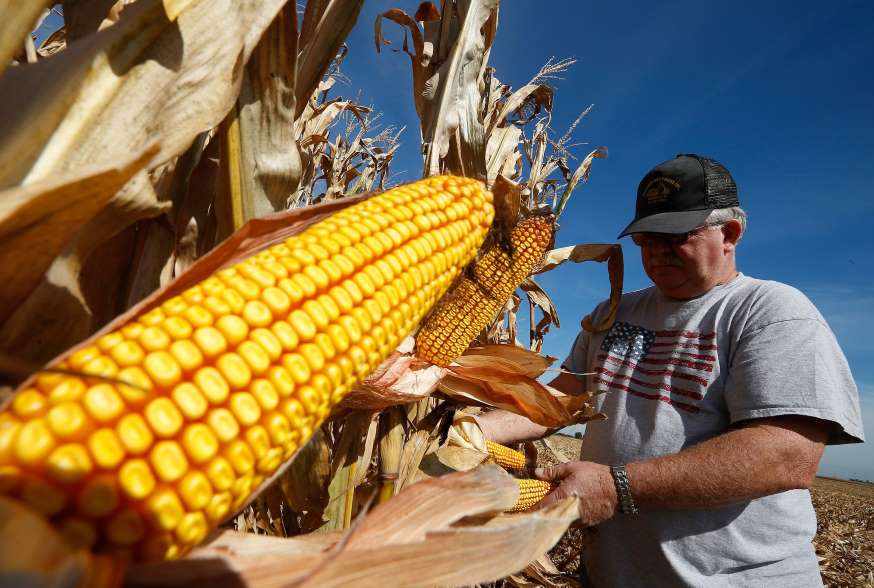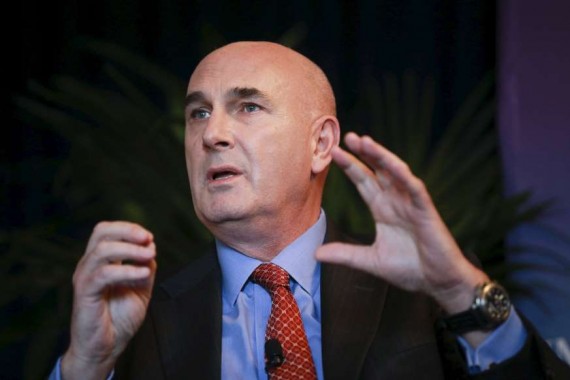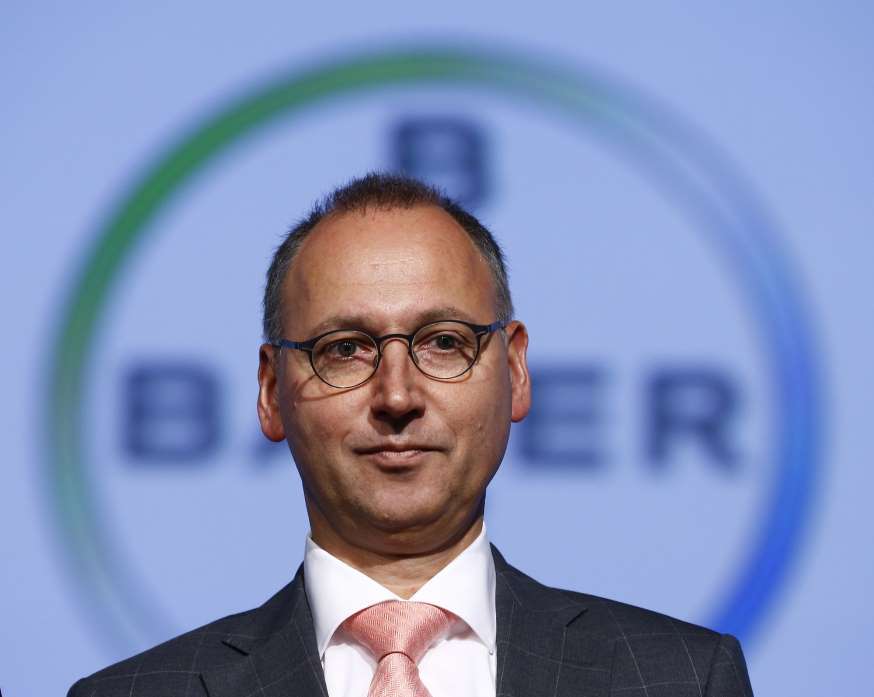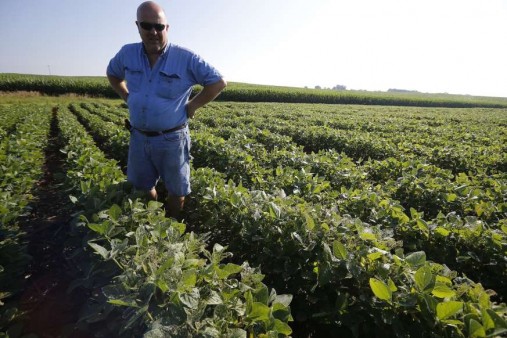Business Insider.

By the time President Donald Trump took office, he had already gotten involved in one of the world’s biggest mergers.
In mid-January, the CEOs of Bayer and Monsanto, Werner Baumann and Hugh Grant, reported in a joint statement that they had a “very productive meeting” with the incoming president about their potential $66 billion merger.The deal, which the two companies announced in September, would combine the German pharmaceutical and chemical group with the US seed giant — a move they claim would boost agriculture research and innovation.“By the time 2050 rolls around, the world will have 10 billion people and the demand for food will double,” Robb Fraley, Monsanto’s Chief Technology Officer, tells Business Insider. “The whole point here is that the business combination between Monsanto and Bayer will allow the companies to invest in and create more innovation, and it’s going to take a huge amount of innovation in order to double the world’s food supply.”
Farmers aren’t so sure.
“From my perspective, they’re saying the exact opposite of what most people in the industry actually believe,” Clay Govier, a farmer in central Nebraska, tells Business Insider. Govier is the fifth generation to work on his family farm of 3,000 acres, which primarily grows corn and soybeans. The farm has used Monsanto products for at least 12 years, and if this merger goes through, Govier’s family expects seed and chemical prices to increase.
With both corn and soybean commodity prices at some of the lowest levels they’ve been since 2012, that could put many small family farms in tough positions.
“I just sat down to chat with my banker the other day, and fortunately we’re in a position that I don’t think we’re going to have to have a hard conversation when it comes to loans for next year. But he said there are a lot of guys out there that are going to have a really hard conversation,” Govier says. With the increasing consolidation of the agriculture supply industry (Monsanto-Bayer is one of three major mergers on the table, along with Dow-DuPont and Syngenta-ChemChina), Govier doesn’t expect things to get easier anytime soon.
“They’re locking in their profit and they’re cornering the market by getting bigger, not by creating new products,” he says of Bayer and Monsanto. “They’re just choking out the rest of the competition.”

Hugh Grant Monsanto
© Provided by Business Insider Hugh Grant Monsanto
The size of the Bayer-Monsanto deal — it was the biggest merger announced in 2016 after AT&T and Time Warner — means the companies have to seek approval from regulators in 30 countries. The recent Trump Tower get-together, which occurred before the president nominated a Secretary of Agriculture, signaled the deal has a good chance of getting Trump’s approval.
In a statement, Baumann and Grant suggested that the new president shares their view of the agriculture industry’s need for innovation. To that end, the companies highlighted their plan to spend $16 billion on research and development worldwide over six years — an average of $2.67 billion per year.
But a look at their current R&D budgets reveals that added up, the two companies already spend approximately $2.59 billion per year, so the combined increase in funds amounts to less than $500 million over six years.
“Let’s just cut to the chase — these companies want to make more money, they want to raise prices,” says Mark Connelly, an agriculture analyst at brokerage and investment group CLSA Americas. “No company in this industry needs these deals in order to innovate.”
Data compiled by the Farmers Business Network (FBN), a data distribution network that collects crowd-sourced information from members, backs up Connelly’s concern. FBN analyzed corn seed yield (the number of bushels farmers can produce per acre) in relation to the seed brands’ market share; they found that, while increased market share did lead to more innovation, the rise wasn’t proportional.
“After you got to a few percent market share, it really tapered off quite quickly. So going from 5 or 10 percent to 20 or 30 percent market share didn’t lead to a massive yield increase,” says FBN co-founder Charles Baron.
When plotting seed prices in relation to market share, FBN data also showed that greater market dominance was correlated with higher corn seed and chemical prices.
That doesn’t bode well for farmers, since several of the agricultural companies with proposed mergers already make up a significant portion of the market, according to Connelly’s analysis.
“If you look at how much of the farmers’ seed and pesticide dollars are going to these companies, Monsanto-Bayer — if it were one company today — would be getting $1 out of every $3. Dow-Dupont would be taking one out of every $4. Think that’s a problem? Holy c***, right?”

Werner Baumann Bayer
© Provided by Business Insider Werner Baumann Bayer
Bayer representatives acknowledged in a statement to Business Insider that they are often confronted with the allegation that the merger will raise prices and reduce innovation and competition.
“We disagree with this and are convinced the opposite is true,” the company wrote. “We are competing with other very strong companies that offer similar products and have strong R&D capabilities. We will only succeed with pricing and selling our products if our value proposition to our customers is better than that of our competitors and if we continue to innovate. We are also convinced that in a competitive business such as the agriculture industry, the efficiency gains generated by innovation will increase returns for farmers.”
Monsanto’s Fraley estimates that, under the current system, it takes about a decade for a company to develop and get approval for a new herbicide. Then if that product is popular, it’ll take the company another 10 years to make a seed trait that responds to the new chemical. But since Bayer and Monsanto’s combined resources might allow them to develop paired products in tandem, they could halve the time it takes to bring those new products to farmers, he says.
Connelly has a different hypothesis. Monsanto has historically sought out partnerships and joint ventures with other companies that have innovative products. But that means dividing up profits. So Connelly predicts the size of a combined Monsanto-Bayer will lead them to favor a mediocre product or solution that they can develop in-house over a more promising one that would require a revenue-sharing partnership.
“We’re not going to be chasing the best solution anymore — we’re going to be chasing the good enough solution,” Connelly says.

Soybean farmer Illinois
© Provided by Business Insider Soybean farmer Illinois
Todd Eney, a fourth-generation farmer in central Montana, says that as suppliers of seeds and chemicals have become more consolidated, he hasn’t seen many benefits. “These corporate bigwigs, are they really going to do what they say?” he asks. “Our farm has been out here since 1935 and I’m 40 years old and I’ve watched a lot of small family farms in our area go under. They can’t compete because they can’t pay the price of input because of what these companies are wanting to charge for input now.”
Eney’s farm grows wheat, malt barley, and field peas, and uses Roundup, Monsanto’s popular weed killer. This year, he says, he and his father decided to use 50% less fertilizer in order to cut costs. The possibility of further consolidation has him on edge.
Clay Govier has a similar feeling.
“You know, it’s almost like you shrug your shoulders and cross your fingers that your regulators are going to have a backbone and not let it happen,” he says.
Article Source: http://www.msn.com/en-us/money/markets/trump-could-approve-a-giant-merger-thats-scaring-american-farmers/ar-AAmEvo9?li=BBnbfcL
Related Information